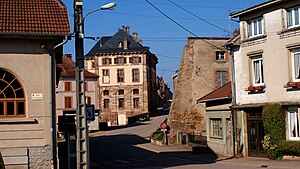Badonviller
| Badonviller | ||
|---|---|---|

|
|
|
| region | Grand Est | |
| Department | Meurthe-et-Moselle | |
| Arrondissement | Luneville | |
| Canton | Baccarat | |
| Community association | Vezouze en Piémont | |
| Coordinates | 48 ° 30 ' N , 6 ° 54' E | |
| height | 284-524 m | |
| surface | 21.95 km 2 | |
| Residents | 1,551 (January 1, 2017) | |
| Population density | 71 inhabitants / km 2 | |
| Post Code | 54540 | |
| INSEE code | 54040 | |
| Website | www.ville-badonviller.fr | |
 Place de la République |
||
Badonviller ( German Badenweiler ) is a French commune with 1,551 inhabitants (as of January 1, 2017) in the Meurthe-et-Moselle department in the Grand Est region (until 2015 Lorraine ).
geography
The municipality of Badonviller is located on the western edge of the Vosges near the border with the Vosges department , about 15 kilometers from Baccarat and 30 kilometers from Lunéville . The small river Blette , a tributary of the Vezouze , crosses the village.
history
Founded in Gallo-Roman times, the place was first mentioned in 1124 as a Baldovillare . Then Baltzweiler (1552) and Pfaltzweiller (1665).
It was fortified in the 13th century, but the fortifications were demolished during the Thirty Years' War . The city was the residence of the Counts Salm-en-Vosge and the capital of the Principality of Salm until 1751, when these functions moved to Senones . A short time later, the principality became part of the Duchy of Lorraine and finally French in 1766.
Badonviller was mainly shaped by the textile industry.
In the First World War was Badonviller and its surroundings theater of war. Hundreds of soldiers were killed on both sides in an assault on the city on August 12, 1914. The place was burned down by the Germans, civilians were shot or sent to Germany as prisoners. More fighting followed in the region. In France, the events in and around Badonviller were a symbol of German atrocities. In 1918 the municipality was therefore given the title Cité martyre .
On the German side, the regimental bandmaster Georg Fürst composed the Badonviller March , which was very popular during the National Socialist era.
Badonviller was also badly damaged in World War II. The liberation from the German occupation took place by the French 2nd Panzer Division under Major General Leclerc on November 17, 1944, after Strasbourg had initially been captured.
Population development
| year | Residents |
|---|---|
| 1962 | 2143 |
| 1968 | 2050 |
| 1975 | 1920 |
| 1982 | 1812 |
| 1990 | 1660 |
| 1999 | 1512 |
| 2007 | 1588 |
coat of arms
The city coat of arms bears two golden, outwardly curved Salme, emblem of the Salm family, from the Salm valley, one of the tributaries of the Meuse in the Belgian Ardennes, in a red field. They are accompanied by seven golden crosses. This coat of arms was used by the Counts of Salm in Wasgau.
Attractions
- Numerous water sources and various old bathhouses
- Church of St. Martin: The original church building in the style of Louis XVI. was described as Little Saint Peter in Rome . The royal chief engineer François-Michel Lecreulx (1734-1812) built the building in 1787/88. Nine days after the outbreak of World War I, on August 12, 1914, the church building burned down completely during the fighting. Reconstruction began as early as 1921. Soon St. Martin had all four bells back with the remarkable round bell tower. The most powerful bell named Edith weighs 2150 kg. The sound of the bell reminds you of Big Ben in London. Your organ is the work of Ernest Jacquot, organ builder from Rambervillers.
- The Sherman tank Mort-Homme from Leclerc's 2nd Panzer Division: The tank was damaged here on November 17, 1944 and has been on display in Badonviller ever since.
Personalities
The astronomer Charles Messier (1730–1817) and the painter Jean Baptiste Claudot (1733–1805) are the city's most famous sons.
Web links
- Badonviller official website (French)
- Private website for Badonviller (French, needs Adobe)





